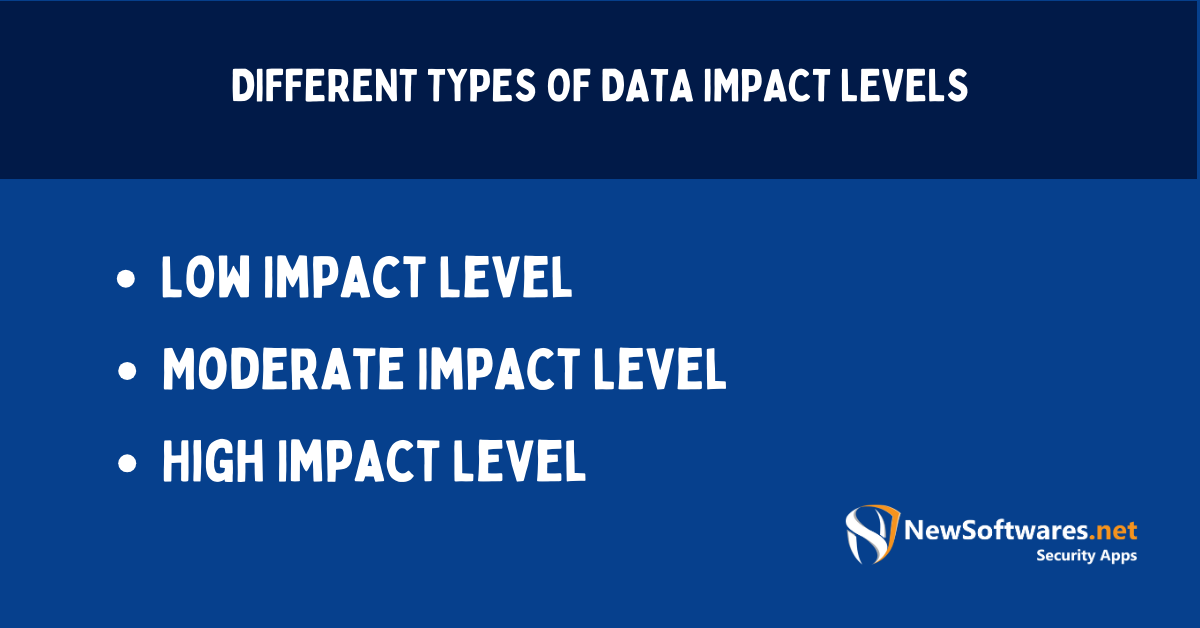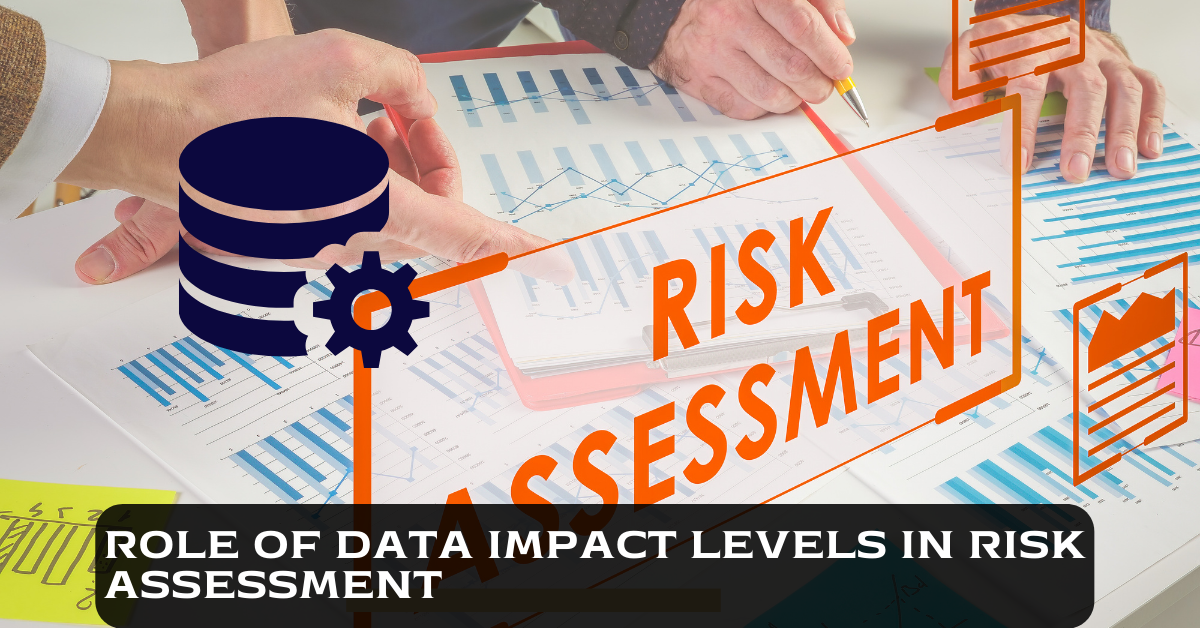Data impact levels categorize data breaches’ sensitivity and potential impact. While specifics can vary, generally, higher levels indicate greater sensitivity and risk.
In information security, data impact levels are crucial in safeguarding valuable assets and preventing potential breaches. Understanding these levels is essential for organizations to develop robust risk management strategies and ensure their data’s confidentiality, integrity, and availability.
Understanding Data Impact Levels
At its core, data impact levels provide a framework for categorizing and evaluating the potential impact of a security event on an organization’s information assets. Organizations can determine the appropriate security controls and measures needed to protect that data by assigning a specific impact level to each data type.
Data impact levels are not just arbitrary classifications; they are carefully defined and structured to ensure that the right level of protection is applied to each data type. These impact levels consider various factors, such as the sensitivity of the data, its value to the organization, and the potential harm that could result from unauthorized access or disclosure.
Defining Data Impact Levels
Data impact levels are typically categorized into three main tiers: low, moderate, and high. These levels represent the potential consequences of a security breach on data confidentiality, integrity, and availability.
Low-impact data refers to information that, if compromised, would have minimal adverse effects on the organization. This could include publicly available information or data that is easily replaceable. While the loss or unauthorized access to low-impact data may not significantly impact the organization, it is still important to protect it to maintain public trust and comply with regulations.
Moderate impact data, on the other hand, includes information that, if compromised, could result in moderate harm to the organization. This could include sensitive customer data, internal documents, or proprietary information. Breaches involving moderate impact data could lead to financial loss, reputational damage, or legal consequences. Therefore, organizations must implement stronger security measures to protect this data type.
High-impact data represents the most critical and sensitive information assets of an organization. This could include trade secrets, intellectual property, financial records, or personally identifiable information (PII). Breaches involving high-impact data can have severe consequences, such as significant financial loss, regulatory penalties, or even the organization’s collapse. As a result, organizations must implement the highest level of security controls to safeguard this valuable data.
Importance of Data Impact Levels in Information Security
Data classification into impact levels is crucial for information security practitioners and decision-makers. It allows them to prioritize security efforts, allocate resources effectively, and focus on protecting the most sensitive and critical information assets.
By understanding the potential impact of a security breach on different types of data, organizations can tailor their security measures to address specific risks and vulnerabilities. This targeted approach ensures that resources are not wasted on excessively protecting low-impact data while preventing underinvestment in securing high-impact data.
Furthermore, data impact levels help organizations comply with industry standards and regulatory requirements. Many rules, such as the General Data Protection Rule (GDPR) and the Health Insurance Portability and Accountability Act (HIPAA), require organizations to implement suitable security panels based on the sensitivity of the data they handle. Using impact levels enables organizations to demonstrate compliance and avoid legal and financial consequences.
In conclusion, data impact levels play a vital role in information security. They provide a structured framework for categorizing and evaluating the potential impact of a security event on an organization’s data. By understanding the importance of data impact levels and implementing appropriate security measures, organizations can efficiently protect their information assets and mitigate the risks associated with data breaches.
Different Types of Data Impact Levels

Understanding the various types of data impact levels is crucial for organizations to prioritize their security measures effectively. To better understand their characteristics and implications, let’s delve deeper into each data impact level.
Low Impact Level
At the low-impact level, data breaches typically have minimal adverse effects on an organization. The compromised information might not significantly impact operations, customer privacy, or the organization’s reputation. However, this does not imply that low-impact data should be overlooked or left unsecured.
Even though the consequences may be less severe, organizations must implement basic security controls to protect against potential threats. This contains firewalls, antivirus software, and regular data backups. By taking these precautions, organizations can minimize the danger of a breach and maintain the trust of their stakeholders.
Moderate Impact Level
With moderate impact data, the stakes are higher. Breaches involving this level of data could lead to significant repercussions, affecting business operations, customer trust, and compliance requirements. Organizations must recognize the importance of securing this type of data.
Security measures for moderate-impact data should be more robust compared to low-impact data. This includes implementing access controls to limit unauthorized access, encrypting sensitive information to protect it from unauthorized disclosure, and conducting regular audits to identify and address potential vulnerabilities. By adopting these measures, organizations can enhance their data protection capabilities and mitigate the risks associated with moderate-impact data breaches.
High Impact Level
The highest data impact level carries the most severe consequences. A breach involving high-impact data can have catastrophic effects on an organization, including financial losses, legal ramifications, and damage to its reputation. To safeguard this critical information, organizations must guarantee the highest level of security controls, continuous monitoring, and incident response protocols.
Organizations should implement advanced security measures to fortify their defenses when dealing with high-impact data. This includes employing multi-factor authentication to strengthen access controls, utilizing encryption algorithms with strong cryptographic keys, and regularly conducting comprehensive security assessments to proactively identify and address any vulnerabilities.
In addition to preventive measures, organizations should establish robust incident response protocols to handle potential breaches effectively. This includes having a well-defined plan in place, training employees on incident response dealings, and leading regular drills to test the effectiveness of the response plan.
Organizations can make informed decisions regarding their security strategies by understanding the characteristics and implications of different data impact levels. Protecting data at all impact levels is essential for maintaining customers’ trust, complying with regulations, and safeguarding the organization’s overall well-being.
Role of Data Impact Levels in Risk Assessment

Risk assessment is a crucial component of information security. Data impact levels play a key role in this process by providing a standardized method for evaluating potential threats and their impact. Let’s explore how data impact levels contribute to risk assessment.
Identifying Potential Threats
By analyzing the impact levels assigned to different types of data, organizations can identify potential threats and vulnerabilities that could compromise their information’s confidentiality, integrity, or availability. This allows them to implement preventive measures and mitigate risks proactively.
For example, let’s consider a healthcare organization that stores patient records. The organization assigns a high impact level to these records due to the sensitive nature of the information they contain. This high impact indicates that any unauthorized access or disclosure of patient records could have severe penalties, such as identity theft or medical fraud.
With this knowledge, the organization can focus on implementing robust access controls, encryption mechanisms, and monitoring systems to protect patient records from potential threats. They can also allocate resources and budget accordingly to address the highest impact areas first.
Evaluating the Severity of Impact
Data impact levels assist organizations in assessing the severity of the impact associated with a security incident or breach. This evaluation helps determine the appropriate response and recovery measures needed to minimize damage and restore normal operations as swiftly as possible.
Continuing with the healthcare organization example, let’s imagine that a security incident occurs and a breach in the patient records database. The impact level assigned to these records allows the organization to quickly understand the severity of the breach and its potential consequences.
Based on the impact level, the organization can activate its incident response plan, including isolating affected systems, conducting forensic analysis, notifying affected individuals, and implementing additional security measures to prevent future incidents.
The severity of the impact also influences the recovery measures the organization needs to undertake. In this case, the organization would prioritize restoring the integrity of the patient records, ensuring that any tampering or unauthorized changes are detected and corrected.
Furthermore, the organization may need to assess the breach’s potential legal and regulatory implications, as high-impact incidents often require reporting to authorities and affected individuals.
In conclusion, data impact levels are an essential tool in risk assessment. They enable organizations to identify potential threats, evaluate the severity of impact, and implement appropriate preventive and recovery measures. Organizations can enhance their information security posture and protect their valuable assets by incorporating data impact levels into their risk management processes.
Implementing Data Impact Levels in Security Protocols
Once data impact levels have been established and understood, it’s crucial to incorporate them into robust security protocols and policies.
Incorporating Impact Levels in Security Policies
Organizations should develop security policies that align with the defined impact levels, ensuring adequate protection measures are in place for each level. These policies should address access controls, encryption standards, data retention, and incident response processes.
Ensuring Compliance with Impact Level Requirements
Compliance with data impact level requirements is of utmost importance for organizations. Regular audits and assessments should be conducted to ensure that security protocols align with industry standards and regulatory requirements. Any necessary adjustments or enhancements should be made promptly.
Challenges in Managing Data Impact Levels
While data impact levels are undoubtedly beneficial for information security, managing them comes with challenges.
Balancing Security and Accessibility

One of the main challenges organizations face is striking a balance between stringent security measures and the accessibility of data. Implementing high-level security controls might hinder the flow of information and impede productivity. Finding the right equilibrium is essential to maintain operational efficiency while safeguarding sensitive data.
Keeping Up with Evolving Threats
The threat landscape constantly evolves, with new vulnerabilities and attack vectors emerging daily. Organizations must stay vigilant and adapt their data impact levels and security measures accordingly. Regular risk assessments, threat intelligence, and continuous training are essential to keep up with evolving threats and implement effective countermeasures.
Key Takeaways
- Data impact levels help prioritize data based on its sensitivity.
- The levels often range from public data to top-secret or classified data.
- Higher levels usually require stricter security measures.
- Each level has its own set of access and handling protocols.
- Organizations can customize these levels based on their risk assessments.
FAQs
Q: Why are data impact levels important?
A: They help organizations prioritize security resources and understand the risks associated with various data types.
Q: Does every organization need to implement data impact levels?
A: While not mandatory, it’s recommended for organizations to understand and classify their data for better security management.
Q: Can an organization customize its data impact levels?
A: While general standards exist, organizations can adjust levels based on their unique needs and risk assessments.
Q: Are higher impact levels always more secure?
A: They should be, as they indicate higher sensitivity and risk. This means stricter security measures should be in place for higher impact levels.
Q: How often should organizations review their data impact levels?
A: It’s a best practice to review data classifications periodically, especially when there are changes in data handling, regulations, or the risk landscape.
Conclusion
In conclusion, data impact levels are a critical component of information security. By understanding and categorizing data according to its impact level, organizations can implement appropriate security controls, perform comprehensive risk assessments, and protect their valuable assets against potential threats. While challenges exist, staying proactive and adapting to the changing landscape will ensure that data remains secure in an ever-changing digital world.
